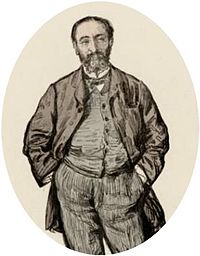Le timbre d'argent
| Le timbre d’argent | |
|---|---|
| Opera by Camille Saint-Saëns | |

The composer in 1875
|
|
| Description | opéra fantastique |
| Librettist | |
| Language | French |
| Premiere | 23 February 1877 Théâtre de la Gaîté, Paris |
Le timbre d’argent (The Silver Bell) is an opéra fantastique in four acts by composer Camille Saint-Saëns to a French libretto by Jules Barbier and Michel Carré. Although completed in 1865, the opera did not receive its premiere performance until 23 February 1877, when it was presented by Albert Vizentini's Théâtre National Lyrique at the Théâtre de la Gaîté in Paris. It includes the well-known aria "Le bonheur est chose légère."
Le timbre d’argent is the first opera that Saint-Saëns composed. The opera was commissioned by the Théâtre Lyrique and he began composing the music for it in 1864, finishing in 1865. The work's premiere was delayed, first by the financial difficulties of the opera house and then later by the Franco-Prussian War. Over the next 12 years Saint-Saëns recomposed the dialogue to form a Grand Opera version, but Albert Vizentini and his Théâtre National Lyrique, who finally staged it, decided to use the original 1865 rendition for the opera's premiere in 1877. The grand opera version was first performed in 1913.
Conrad, an artist, has an unhealthy obsession for gold, and is further engrossed by his own painting of Circe, embodied in the living world by Fiametta, a ballerina. Conrad is given a silver bell by Dr Spiridion: when he strikes the belt he will receive all the gold he craves for, but at the cost of someone’s death. The opera concludes with the realization that all of the events have only occurred within Conrad's own fevered mind.
The librettists for Le timbre d’argent also notably penned the librettos for Gounod’s Faust and Offenbach’s Les contes d'Hoffmann, and Saint-Saëns's opera serves as a "significant link" between these two. All three of these operas explore the hero’s reliance on a menacing older man imposed by a diabolic pact. The character of Conrad is similar in many ways to that of Hoffman in Offenbach's opera, and the villainous character of Dr. Spiridion correspond well to Offenbach's villains (Lindorf, Coppélius, Dapertutto, and Dr Miracle).
...
Wikipedia
